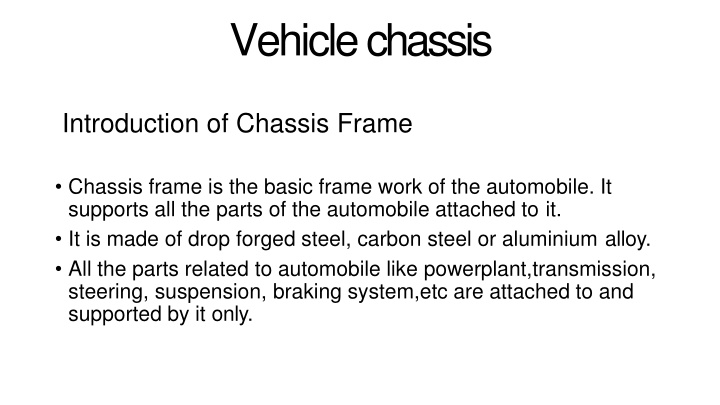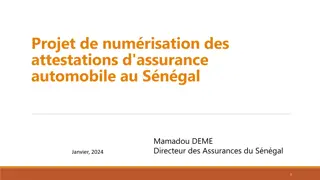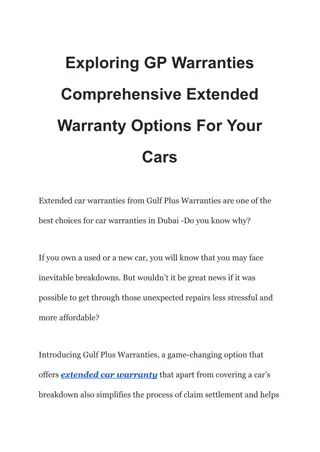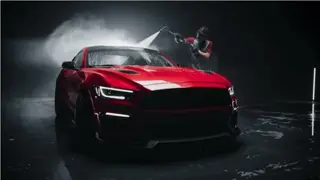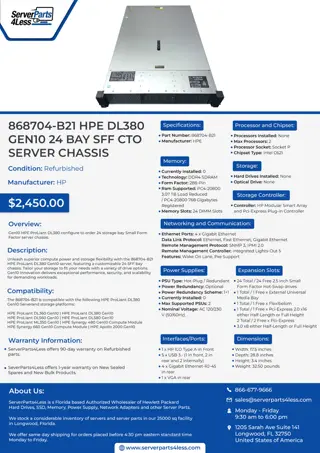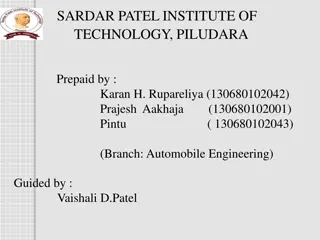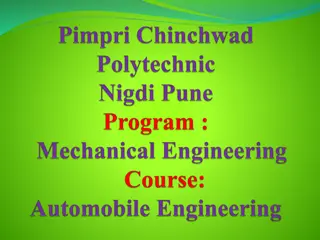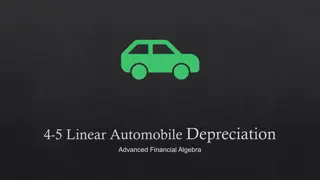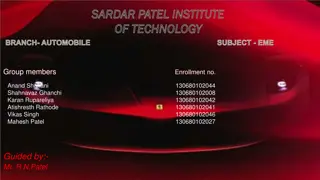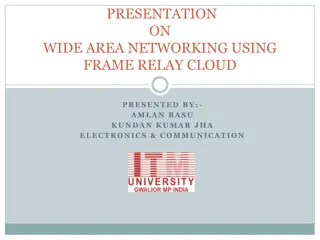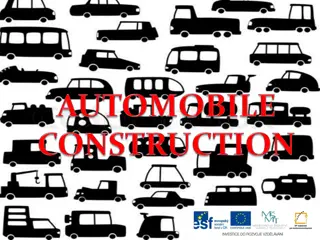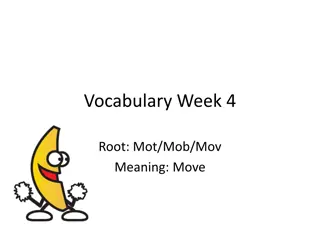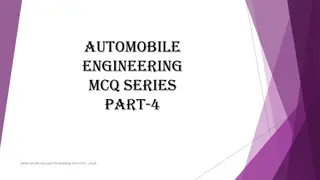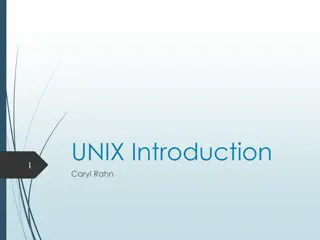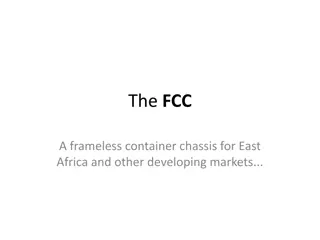Automobile Chassis: Frame, Operating Conditions, and Components
The chassis frame is a crucial component of an automobile, supporting all attached parts like the powerplant, transmission, steering, suspension, and braking system. It undergoes loading conditions such as vertical bending, longitudinal torsion, lateral bending, and horizontal lozenging. Various car body styles like hatchback, sedan, SUV, coupe, and more offer different designs for vehicles.
Download Presentation

Please find below an Image/Link to download the presentation.
The content on the website is provided AS IS for your information and personal use only. It may not be sold, licensed, or shared on other websites without obtaining consent from the author.If you encounter any issues during the download, it is possible that the publisher has removed the file from their server.
You are allowed to download the files provided on this website for personal or commercial use, subject to the condition that they are used lawfully. All files are the property of their respective owners.
The content on the website is provided AS IS for your information and personal use only. It may not be sold, licensed, or shared on other websites without obtaining consent from the author.
E N D
Presentation Transcript
Vehicle chassis Introduction of Chassis Frame Chassis frame is the basic frame work of the automobile. It supports all the parts of the automobile attached to it. It is made of drop forged steel, carbon steel or aluminium alloy. All the parts related to automobile like powerplant,transmission, steering, suspension, braking system,etc are attached to and supported by it only.
Chassis OperatingConditions: Thedesignof anautomobile chassisrequiresprior understanding of the kind of conditionsthe chassis is likely to face on the road. The chassis generally experiences four major loading situations, thatinclude, (i) vertical bending(symmetric) (ii) longitudinal torsion(asymmetric verticalloads) (iii) lateral bending,and (iv) horizontallozenging. Vertical Bending. Considering a chassis frame is supported at its ends by the wheel axles anda weight equivalent to the vehicle s equipment,passengers and luggage is concentrated aroundthe middle of its wheelbase,thenthe side-membersaresubjectedto verticalbending causing them to sagin the centralregion.(figure nextto longitudinal bending) Longitudinal T orsion. When diagonally opposite front and rear road-wheels roll over bumps simultaneously,the two endsof the chassisaretwisted in opposite directionssothat both the side and the cross-members are subjected tolongitudinal torsion (Fig. 21.2), which distorts the chassis.
Fig. 21.2. Longitudinaltorsion. Lateral Bending. The chassis is exposed to lateral (side) force that may be due to the camber of the road, side wind, centrifugal force while turning a corner, or collision with some object. The adhesion reaction of the road-wheel tyres opposes these lateral forces. As a net result a bending moment (Fig. 21.3) acts on the chassis side members so that the chassisframe tends to bow in the direction of the force. Fig. 21.3. Lateral bending.
Horizontal Lozenging. A chassis frame if driven forward or backwards is continuously subjected to wheel impact with road obstacles such as pot- holes, road joints, surface humps, and curbs while other wheels produce the propelling thrust. These conditions cause the rectangular chassis frame to distort to a parallelogram shape, known as lozenging (Fig.21.4). Fig. 21.4.Lozenging.
Types of carbody: Some of the important car body styles are as mentionedbelow. 1.Hatchback 2. Sedan(saloon) 3. MUV/SUV 4. Coupe 5.Convertible 6.limousine 7. Van 8. Jeep 9.Pickupvehicle
The small cars with 4 doors and a boot (dickey) door are classified under hatchback. Generally these are designed for comfortable seating of 4passengers and small boot space for putting one or two bags. The size of hatchback varies depending upon design. It could be super mini, or a larger one. The design is same but interior size and luggage spacevaries. In this type of vehicle theentire back gate can be lifted.
Sedans are the cars designed to for comfortable seating of 5 passengers. Sedans come with larger trunk sizes which can be used for carrying larger amount of luggage. The features ofsedan includes larger overall dimensions i.e. length, width, height and wheel base. Many times the existing hatchback car design is itself used for sedan with boot spaceextended.
Although the MUV (Multi Utility Vehicle) and SUV (Sport UtilityVehicle) sport similar designs, the twoare significantly different. MUVvehiclesaredesignedto createutility.Therewould beflexibleseating options ranging from 7, 8, 9 and 10 so on. The body is built on chassis frame and can carry large amounts ofluggage. SUV are vehicles designed to use in all road conditions, ranging from highwaysto crosscountry roads.Inthis type, importanceis givenfor all factors such as usage of advanced technology for engine,gearbox, differential, 4WD option, interior space. SUV s have features suited forlong drives,good technology for suspensions, and so on.The main point about SUV is the importance given to fit and finish (both interior and exterior) and drivequality.
Coupe is the name given to sedan cars with two doors only.The two doors are bit larger and though rear seat is available in some models, one can go to inside through sliding of front seats. Here main importance is given to styling, luxury and image. Coupe design is used mostly in Europeancountries
Convertible cars are the cars whose roof line can be removed or refitted as required. Generally it s available in high end vehicles. Electro mechanical devices are used for step by step folding of the roof lines. In earlier vehicles leather material were used. In modern vehicles the metal roof lines with design of folding part by part andeventually rest on/in trunk part of the vehicle.Operatingof a button isgoodenough for folding or putting backthe roof linings. Convertibles are more frequently used in cold countries wherein weather temperature is quite less and also roads have lesser dusty conditions.It s purely a preferred choice for persons with passion of usingstylish carsandthe feel ofair in hair when driving vehicle. luxury
Van is the name given to cars with main perspective of flexibility in utilizing the interior space. It has options of varying number of seats and hence luggage space .Best Example are the Maruti Suzuki Omni, Eeco. There is difference in the vehicles (particularly Van) used purely for commercial purposeandfor the oneusedfor passengerpurpose.
Pick up vehicle (Pick up Van) is the term used for the MUVwith separate space for luggage. There would be spacious interiors for comfortable seating of 5 passengers and separate luggage space available behind the passenger cabin.The dimensions of vehicle would be larger and body is built on chassis frame so that load carry capacity can be considerably large. Generally it could be around800Kg.
Jeepisaparticular type of vehiclesimilar to that of MUVbut there is option for hardtop or soft top. This type of vehicle has good combination of utility like that of a sports car and cost like that of a MUV and hence can be bestsuitable one for cross country usage and taking out for adventure drive in forests.
CLASSIFICATION OF BUSES Passenger carrying buses are classifies based on: 1)Distance traveled by the vehicle 2)Capacity of the vehicle 3)Shape and Style of the vehicle
1.Distance traveled by the vehicle: 1. MINI BUS:
It should have a seating capacity upto 25. It built on light duty truck chassis. It has front mounted engine and rear axle drive. It has soft and comfort suspension. It has reasonably comfortable seat. It has fairly small entry platforms.
These buses are used for a short distance of about 20-30kms. They are provided with large number of standing places, wide doors with large entry and exit platform and hard seats covered with durable plastic materials. Due to short intervals between stops in local traffic, such busses are provided with wide entrance and exit doors with low steps entry and exit platform.
These buses are used for a distance of about 40 to 50 kms. They usually have reasonably comfortable seats. Seating capacity of 38 persons with roof rack for hand luggage
For longer distance touring coaches, very comfortable reclining seats are used. Toilets, air conditioners, TV,VCR,etc are provided. Additional windows in the roof are used to improve visibility for the passengers. Thermal and acoustic insulation is usually elaborate and spacious luggage compartments are provided under the floor and on the roof .
3.Based on Shape and Style of the vehicle Classic type Single Decker Double Decker Split level bus Two level single Decker Articulated bus
The Classic or normal control bus has the engine in front of the passenger carrying compartment. This design, which was almost universal at one time, has practically disappeared and is mainly of historical interest. Low ratio of useful length to overall length. It also has a high tare weight and poor aerodynamic shape. Now a days it is mainly use for school buses.
The fulllength bodywork, i.e. single deck bus or coach is almost universal today as this layout eliminates all the disadvantages of classic type. In this busses tahe engine is mounted either insideor below the drivers cab, enabling additional length available for more seatsand better angle ofvision. Has seating capacity of 52.
These buses have a greater number of seats for a given overall length than a single Decker. stability is not so high as for the single Decker. Has capacity of 65-75. It may have upper deck open for tourists. Engine is mounted on rear giving better visibility for passenger and driver.
Twolevel single Decker has been used for luxury coaches. This layout provides good forward visibility for all passengers, good luggage space and easy installation of an under floor or rear engine. Again this type is only made for special orders, as it is not easy to make derivations from the same body shell.
Bodies for very large coaches or in particular, city buses are often made in two parts because of axle load limitations. The rear portion is articulated to the main vehicle by a covered pivot allowing easy access between the two sections. A bi articulated bus or double articulated bus is an extension of an articulated bus in that it has three passenger compartment sections instead of two. This also involves the addition of an extra axle. Due to the extended length, bi articulated buses tend to be used on high frequency core routes or bus rapid transit schemes rather than conventional bus routes. Mainly uses for in-city operation.
a. Channel Section -Good resistance to bending b. Tabular Section-Good resistance to Torsion c. Box Section-Good resistance to both Bending and Torsion
Buses are categorized into fourTypes, namely, 1) Type I 2) Type II 3) Type III 4) Type IV Type I Vehicles are the medium and high capacity vehicles designed and constructed for urban and sub urban / city transport with area for standing passengers. Type II Vehicles are those designed and constructed for inter-urban/inter-city transport without specified area for standingpassengers Type III Vehicles are those designed and constructed for long distance passenger transport, exclusively designed for comfort of seated passengers and not intended for carrying standing passengers. Type IV Type IV Vehicles are those designed and constructed for special purpose use such as the following:- (1) School Bus: means vehicles designed and constructed specially for schools, college, and other educationalInstitutions. (2) Sleeper Coaches: means vehicles designed and constructed specially berth to accommodate sleepingpassengers. (3) Tourist Bus: means vehicles designed and constructed for the purpose of transportation of passengers as tourists and may be classified in any one Type of comfortlevels.
Non Deluxe Bus(NDX) means bus designed for basic minimum comfort level. Semi Deluxe Bus(SDX) means a bus designed for a slightly higher comfort level and with provision for ergonomically designed seats. Deluxe Bus(DLX) means a bus designed for a high comfort level and individual seats and adjustable seat backs, improved ventilation and pleasing interiors. A.C. Deluxe Bus(ACX) means a Deluxe Bus which is air conditioned.
